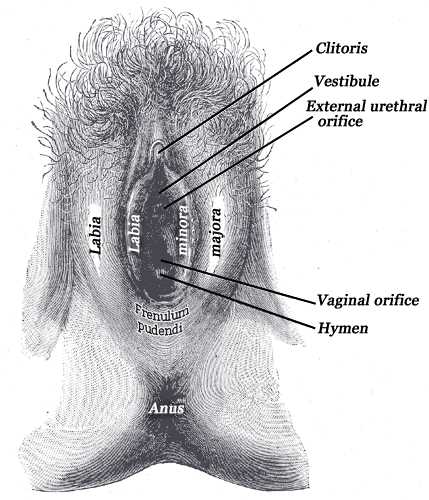[1]
KRANTZ KE. The gross and microscopic anatomy of the human vagina. Annals of the New York Academy of Sciences. 1959 Nov 18:83():89-104
[PubMed PMID: 14411705]
[2]
WELLS LJ. Embryology and anatomy of the vagina. Annals of the New York Academy of Sciences. 1959 Nov 18:83():80-8
[PubMed PMID: 13843905]
[3]
Paavonen J. Physiology and ecology of the vagina. Scandinavian journal of infectious diseases. Supplementum. 1983:40():31-5
[PubMed PMID: 6582587]
[4]
Anderson DJ, Marathe J, Pudney J. The structure of the human vaginal stratum corneum and its role in immune defense. American journal of reproductive immunology (New York, N.Y. : 1989). 2014 Jun:71(6):618-23. doi: 10.1111/aji.12230. Epub 2014 Mar 24
[PubMed PMID: 24661416]
[5]
Forsberg JG. Estrogen, vaginal cancer, and vaginal development. American journal of obstetrics and gynecology. 1972 May 1:113(1):83-7
[PubMed PMID: 5025001]
[6]
Levin RJ. Sexual arousal--its physiological roles in human reproduction. Annual review of sex research. 2005:16():154-89
[PubMed PMID: 16913291]
[7]
Dawson SJ, Sawatsky ML, Lalumière ML. Assessment of Introital Lubrication. Archives of sexual behavior. 2015 Aug:44(6):1527-35. doi: 10.1007/s10508-015-0519-z. Epub 2015 Mar 27
[PubMed PMID: 25813611]
[8]
Chambliss KL, Shaul PW. Estrogen modulation of endothelial nitric oxide synthase. Endocrine reviews. 2002 Oct:23(5):665-86
[PubMed PMID: 12372846]
[9]
Witkin SS, Nasioudis D, Leizer J, Minis E, Boester A, Forney LJ. Epigenetics and the vaginal microbiome: influence of the microbiota on the histone deacetylase level in vaginal epithelial cells from pregnant women. Minerva ginecologica. 2019 Apr:71(2):171-175. doi: 10.23736/S0026-4784.18.04322-8. Epub 2018 Oct 11
[PubMed PMID: 30318873]
[10]
Nunn KL, Forney LJ. Unraveling the Dynamics of the Human Vaginal Microbiome. The Yale journal of biology and medicine. 2016 Sep:89(3):331-337
[PubMed PMID: 27698617]
[11]
Leizer J, Nasioudis D, Forney LJ, Schneider GM, Gliniewicz K, Boester A, Witkin SS. Properties of Epithelial Cells and Vaginal Secretions in Pregnant Women When Lactobacillus crispatus or Lactobacillus iners Dominate the Vaginal Microbiome. Reproductive sciences (Thousand Oaks, Calif.). 2018 Jun:25(6):854-860. doi: 10.1177/1933719117698583. Epub 2017 Mar 17
[PubMed PMID: 28301987]
[13]
Gonçalves B, Ferreira C, Alves CT, Henriques M, Azeredo J, Silva S. Vulvovaginal candidiasis: Epidemiology, microbiology and risk factors. Critical reviews in microbiology. 2016 Nov:42(6):905-27. doi: 10.3109/1040841X.2015.1091805. Epub 2015 Dec 21
[PubMed PMID: 26690853]
[14]
Edwards T, Burke P, Smalley H, Hobbs G. Trichomonas vaginalis: Clinical relevance, pathogenicity and diagnosis. Critical reviews in microbiology. 2016 May:42(3):406-17. doi: 10.3109/1040841X.2014.958050. Epub 2014 Nov 10
[PubMed PMID: 25383648]
[15]
Hoppe-Seyler K, Bossler F, Braun JA, Herrmann AL, Hoppe-Seyler F. The HPV E6/E7 Oncogenes: Key Factors for Viral Carcinogenesis and Therapeutic Targets. Trends in microbiology. 2018 Feb:26(2):158-168. doi: 10.1016/j.tim.2017.07.007. Epub 2017 Aug 17
[PubMed PMID: 28823569]
[16]
Nuovo GJ. The role of human papillomavirus in gynecological diseases. Critical reviews in clinical laboratory sciences. 2000 Jun:37(3):183-215
[PubMed PMID: 10894184]
Level 2 (mid-level) evidence
[17]
Mills BB. Vaginitis: Beyond the Basics. Obstetrics and gynecology clinics of North America. 2017 Jun:44(2):159-177. doi: 10.1016/j.ogc.2017.02.010. Epub
[PubMed PMID: 28499528]
[18]
Horn LC, Klostermann K, Hautmann S, Höhn AK, Beckmann MW, Mehlhorn G. [HPV-associated alterations of the vulva and vagina. Morphology and molecular pathology]. Der Pathologe. 2011 Nov:32(6):467-75. doi: 10.1007/s00292-011-1476-5. Epub
[PubMed PMID: 22038133]
[19]
Scott JR. Episiotomy and vaginal trauma. Obstetrics and gynecology clinics of North America. 2005 Jun:32(2):307-21, x
[PubMed PMID: 15899363]
[20]
Quiróz-Guadarrama CD, Martínez-Ordaz JL, Rojano-Rodríguez ME, Beristain-Hernández JL, Moreno-Portillo M. [Vaginal evisceration. Report of a case and a literature review]. Ginecologia y obstetricia de Mexico. 2013 Jun:81(6):349-52
[PubMed PMID: 23837301]
Level 3 (low-level) evidence
[21]
Farage M, Maibach H. Lifetime changes in the vulva and vagina. Archives of gynecology and obstetrics. 2006 Jan:273(4):195-202
[PubMed PMID: 16208476]
[22]
Lev-Sagie A. Vulvar and Vaginal Atrophy: Physiology, Clinical Presentation, and Treatment Considerations. Clinical obstetrics and gynecology. 2015 Sep:58(3):476-91. doi: 10.1097/GRF.0000000000000126. Epub
[PubMed PMID: 26125962]
[23]
Lethaby A, Ayeleke RO, Roberts H. Local oestrogen for vaginal atrophy in postmenopausal women. The Cochrane database of systematic reviews. 2016 Aug 31:2016(8):CD001500. doi: 10.1002/14651858.CD001500.pub3. Epub 2016 Aug 31
[PubMed PMID: 27577677]
Level 1 (high-level) evidence
[24]
Maher C, Feiner B, Baessler K, Christmann-Schmid C, Haya N, Brown J. Surgery for women with apical vaginal prolapse. The Cochrane database of systematic reviews. 2016 Oct 1:10(10):CD012376
[PubMed PMID: 27696355]
Level 1 (high-level) evidence

